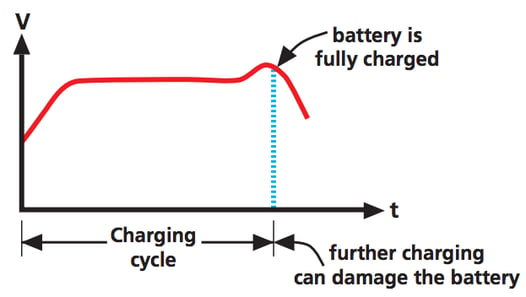Modern electronic loads, such as the AMREL SL Series, are versatile test instruments that should be part of every test engineer's toolbox. Here are some tips on how to use them properly.
Operating Modes
Electronic loads operate in one of four different operating modes:
- Constant current (CC) mode. Most electronic loads are used in constant-current mode. This mode allows users to simulate the different loads that a complex electronic system would present to a power source.
- Constant resistance (CR) mode. When in constant resistance mode, an electronic load behaves just as a load resistor with a particular value would behave.
- Constant voltage (CV) mode. The constant voltage mode is used to test current sources, fuel cells and battery chargers. When testing battery chargers, for example, the electronic load simulates an actual battery, as shown in Figure 1.
- Constant power (CP) mode. Constant power mode is a relatively new operating mode. It is most commonly used for battery and fuel cell testing to determine a device's “storage” capacity.
Dynamic Testing
No matter what mode they're in, all electronic loads can quickly change between two different settings. This capability allows users to characterize how a power source will react to a device turning on or turning off or going from sleep mode to full power mode.
To run this kind of test, a user sets the load into constant current mode, defines two or more current states, the time in each state, and the slew rates between the states. The AMREL SL series can, for example, can switch load values in as short as 50 us (20 kHz).
Low Voltage Testing
Low voltage testing is common in fuel cell characterization and voltage regulators for computers. All electronic loads require a minimum voltage to fully turn on. The minimum voltage for maximum current is typically < 1V, although the AMREL SL series can sink full current at voltages down to 0.6-0.8V.
One way to skirt this limitation is use a power supply in series with the load to boost the voltage seen by the load or use a load with a higher current rating. This works well for fixed load settings, but not so well when a test requires a rapid load change. Often, the power supply cannot keep up with the transients required.
The second solution is to select a load with a higher current rating than required. For example, the AMREL SLH-60- 120-600 load will sink 120A @ 0.8V. In a particular application, the power source operates at 1V. With cabling losses of 0.3V, the actual voltage at the load input is 0.7V. At this voltage the load would sink 0.7 divided by 0.8 times 120A = 105A. However, if the SLH-60-240-1200 load is selected, with the same 0.8V full turn-on, a load of 210A could be pulled. This method retains the full programmability and bandwidth of the load.
For more information, download the application note "DC Electronic Load Selection." You can also contact AMETEK Programmable Power Sales at 858-458-0223 or email the Sales Department at sales.ppd@ametek.com.

